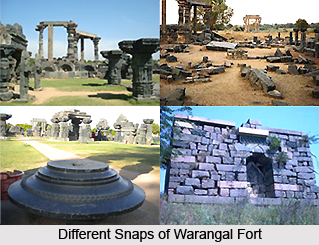The early history of the Kakatiyas is not known to the historians. Some historians regard them as Suryavamsi Kshatriyas, while some of the other historians connect them with Ichhakuas of Andhra Pradesh. There are some historians who connect them with the Sudra dynasty. These opinions are based upon certain inscriptions, found in Nellur district. The Kakatiyas ruled in Tilangana as Samantas of the Chalukyas. After the decline of the Chalukya dynasty, they declared themselves independent and shifted their capital from Amakonda to Warangal.
Prolaraja is supposed to be the earliest king of Kakatiyas. Rudra and Mahadeva succeeded as kings after Prolaraja. Thereafter, Ganapati become the king of this dynasty.
Ganapati.
Ganapati ruled for all total 62 years. It is stated that he was thrown into prison on account of some crime, but he was released by Jaitugi of Yadava dynasty. Jaitugi also helped him to become the king. He is credited with conquests against Latas, Yadavas, Karnata, Kalinga and Cholas. The reason of his victories against these dynasties was the decline of the Chola dynasty.
His first campaign was against Andhra. He attacked the contemporary ruler of Andhra and captured the mines of iron, diamonds etc. He occupied Kanchi after defeating Kulottunga III. He also fought against Anargabhima of Kalinga. Ganapati also achieved victories against the Kayasthas of Kurnool and Budapa.
 Ganapati declared his daughter Rudramba as his successor. She had already been helping him in the administration of the kingdom. The chief of Yadavas had also accepted the sovereignty of Ganapati. Thus it can be seen that Ganapati was a powerful king of this dynasty. He is famous for this efficient administration.
Ganapati declared his daughter Rudramba as his successor. She had already been helping him in the administration of the kingdom. The chief of Yadavas had also accepted the sovereignty of Ganapati. Thus it can be seen that Ganapati was a powerful king of this dynasty. He is famous for this efficient administration.
Rudramba
Ganapati was succeeded by his daughter Rudramba. In her early reign, she remained busy in the struggle with the neighbouring king. A Kayasha chief named Ambadeva defeated all the opponents. Rudramba`s grandson achieved conquest against the Yadavas. On account of his conquest, he was appointed as Yuvaraja in 1280 A. D. With the help of the Hoyasalas and the Yadavas, Ambadeva brought a revolution in the kingdom, but he was defeated by Yuvaraja.
Partapa Rudradeva II
It appears that Rudramba was succeeded by Partapdeva who ruled for 4 years. No significant event took place during his reign. He was succeeded by his son Partapa Rudradeva, who was a very powerful ruler. He defeated the Yadavas. He also attacked Kuntala and occupied the fort of Raichur.
A famous scholar named Vaidyanatha wrote `Prataprudriy`, which has immortalized Pratapa Rudradeva. Pratapa Rudradeva is famous for his efficient administration. He had divided his whole kingdom into 70 Nayakas.
The invasion of the Muslims was the chief cause of the decline of the Kakatiya dynasty. Rudradeva was attacked and defeated by Malik Katura. Thereafter Bahamani Sultan Ahmad Shah conquered and occupied the kingdom of the Kakatiyas. One of the branches of this dynasty ruled for some more time in Baster.



















